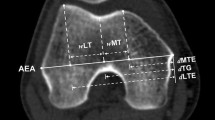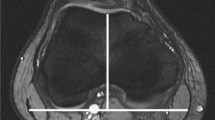Abstract
Purpose
Trochlear dysplasia is one of the most important pathomorphologies predisposing to patellofemoral instability. The development of the trochlea groove is not well understood so far. We hypothesized that the underlying pathology of trochlear dysplasia is a medial hypoplasia.
Methods
110 magnetic resonance imaging (MRI) scans from adult knees, 55 with and 55 without trochlear dysplasia were analyzed. On the axial and sagittal T2 MRI sequences, the height (h), width (w) and depth (d) of the medial (MC) and lateral femoral condyle (LC) as well as the depth of the trochlea groove (dTG) were measured using a three-dimensional measuring algorithm.
Results
For all calculated values of the lateral femoral condyle, the comparison of both groups showed no significant difference (p = 0.95, p = 0.11, p = 0.07). The depth of the trochlear groove (dTG) showed significant lower values in the study group (p < 0.05). In the study group, all measurements of the medial femoral condyle were statistically significantly smaller compared to the control group (p < 0.05).
Conclusions
We found that the height, the width and the depth of the medial condyle is significant smaller in patients with trochlea dysplasia than in healthy controls. The measurements of the lateral femoral condyle showed no significant difference. Patients with a dysplastic trochlea have a hypoplastic medial femoral condyle and a more medially placed trochlea groove compared to controls.






Similar content being viewed by others
References
Biedert RM, Bachmann M (2009) Anterior-posterior trochlear measurements of normal and dysplastic trochlea by axial magnetic resonance imaging. Knee Surg Sports Traumatol Arthrosc 17(10):1225–1230
Dejour D, Le Coultre B (2007) Osteotomies in patello-femoral instabilities. Sports Med Arthrosc 15(1):39–46
Dejour H, Walch G, Neyret P, Adeleine P (1990) Dysplasia of the femoral trochlea. Rev Chir Orthop Reparatrice Appar Mot 76(1):45–54
Dejour H, Walch G, Nove-Josserand L, Guier C (1994) Factors of patellar instability: an anatomic radiographic study. Knee Surg Sports Traumatol Arthrosc 2(1):19–26
Doskocil M (1985) Formation of the femoropatellar part of the human knee joint. Folia Morphol (Praha) 33(1):38–47
Dupont JY (1995) Patellar subluxation: where are we in 1995? Acta Orthop Belg 61(3):155–168
Garron E, Jouve JL, Tardieu C, Panuel M, Dutour O, Bollini G (2003) Anatomic study of the anterior patellar groove in the fetal period. Rev Chir Orthop Reparatrice Appar Mot 89(5):407–412
Hohlweck J, Quack V, Arbab D, Spreckelsen C, Tingart M, Lüring C, Rath B (2013) Diagnostic and therapeutic management of primary and recurrent patellar dislocations-analysis of a nationwide survey and the current literature. Z Orthop Unfall 151(4):380–388
Kohlhof H, Heidt C, Bahler A et al (2015) Can 3D ultrasound identify trochlea dysplasia in newborns? Evaluation and applicability of a technique. Eur J Radiol 84(6):1159–1164
Miller GF (1978) Familial recurrent dislocation of the patella. J Bone Joint Surg Br 60(2):203–204
Nietosvaara Y, Aalto K (1997) The cartilaginous femoral sulcus in children with patellar dislocation: an ultrasonographic study. J Pediatr Orthop 17(1):50–53
Oye CR, Holen KJ, Foss OA (2015) Mapping of the femoral trochlea in a newborn population: an ultrasonographic study. Acta Radio 56(2):234–243
Salzmann GM, Weber TS, Spang JT, Imhoff AB, Schottle PB (2010) Comparison of native axial radiographs with axial MR imaging for determination of the trochlear morphology in patients with trochlear dysplasia. Arch Orthop Trauma Surg 130(3):335–340
Skelley N, Friedman M, McGinnis M, Smith C, Hillen T, Matava M (2015) Inter- and intraobserver reliability in the MRI measurement of the tibial tubercle-trochlear groove distance and trochlea dysplasia. Am J Sports Med 43(4):873–878
Staubli HU, Durrenmatt U, Porcellini B, Rauschning W (1999) Anatomy and surface geometry of the patellofemoral joint in the axial plane. J Bone Joint Surg Br 81(3):452–458
Stepanovich M, Bomar JD, Pennock AT (2016) Are the current classifications and radiographic measurements for trochlear dysplasia appropriate in the skeletally immature patient? Orthop J Sports Med 4(10):2325967116669490
Tardieu C, Dupont JY (2001) The origin of femoral trochlear dysplasia: comparative anatomy, evolution, and growth of the patellofemoral joint. Rev Chir Orthop Reparatrice Appar Mot 87(4):373–383
Walmsley R (1940) The development of the patella. J Anat 74(Pt 3):360–368
Funding
There is no funding source.
Author information
Authors and Affiliations
Corresponding author
Ethics declarations
Conflict of interest
Each author certifies that he or she has no commercial associations (e.g., consultancies, stock ownership, equity interest, patent/licensing arrangements, etc.) that might pose a conflict of interest in connection with the submitted article.
Ethical approval
This article does not contain any studies with human participants or animals performed by any of the authors.
Additional information
Publisher's Note
Springer Nature remains neutral with regard to jurisdictional claims in published maps and institutional affiliations.
The work was performed at the Knee and Hip Institute Munich.
Rights and permissions
About this article
Cite this article
Keshmiri, A., Schöttle, P. & Peter, C. Trochlear dysplasia relates to medial femoral condyle hypoplasia: an MRI-based study. Arch Orthop Trauma Surg 140, 155–160 (2020). https://doi.org/10.1007/s00402-019-03233-4
Received:
Published:
Issue Date:
DOI: https://doi.org/10.1007/s00402-019-03233-4




